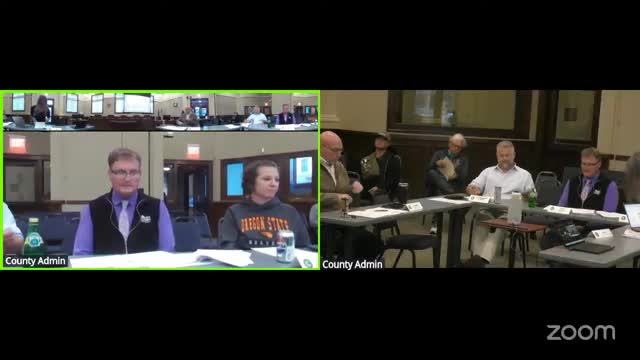Clatsop County details allocation plan for $1.8 million in state shelter funding
October 23, 2025 | Clatsop County, Oregon
This article was created by AI summarizing key points discussed. AI makes mistakes, so for full details and context, please refer to the video of the full meeting. Please report any errors so we can fix them. Report an error »

Clatsop County managers told commissioners the county has a signed contract from the Oregon Housing and Community Services (OHCS) for $1.8 million to support emergency shelter services in fiscal 2025–26 and outlined a formula to distribute the funds to local providers.
Monica Seel, county manager, said the county will retain 7% for administrative duties as the regional renewal coordinator (about $127,857.17), leaving $1,698,673.83 to pass through to service providers.
Seel said the county divided the allocation into two main pools to preserve the intent of the original state awards: 75% (the “created beds” pool tied to House Bill 5019) and 25% (the “maintain existing beds” pool tied to SB 5511). That produces $1,272,113.99 for created-bed providers and $426,559.84 for the maintain-existing-bed providers.
To balance fixed costs and per-bed service differences, the county’s formula further splits each pool: 50% of a pool goes to base costs (utilities, rent/mortgage, maintenance) divided evenly among eligible providers; the remaining 50% is allocated on a per-bed basis weighted by factors including funding diversification, whether the shelter offers 24-hour access (which yields a full point under the formula), and connections to behavioral-health and substance-use services.
Using that method, Seel said the created-bed base and per-bed shares result in allocations of approximately $817,416.71 for Clatsop Community Action (CCA) — $14,093.39 per bed — and $454,697.27 for Lifeboat Services — $20,668.06 per bed. For the maintain-existing-bed pool, Helping Hands and The Harbor each receive $106,639 for base costs, with a remaining per-bed share allocated by the formula.
Seel emphasized the award is smaller than prior tranches and urged providers to diversify funding streams. The county still awaits other state contracts for rehousing and long-term rental assistance (the Oregon Rehousing Initiative and Long-Term Rental Assistance); those contracts were not finalized at the time of the meeting.
All four provider contracts are on the consent calendar for board approval; Seel said the county has signed contracts with all but one provider and will proceed if that provider signs. She said the county expects to apply to become a formal regional coordinator under forthcoming state rules, noting the current county role is similar to the regional coordinator duties that the state is developing.
Commissioners asked about per-bed cost differences between providers and whether the county can sustain services if state funding declines. Seel said the county’s calculations try to balance base and per-bed needs and that the shelter bed system remains important: the county’s point-in-time homelessness count showed persistent demand and providers rehoused more than 228 households under recent programs, she said.
Seel and commissioners agreed state funding alone will not be sufficient over the long term and that the county and its partners must pursue diversified revenue and operational efficiencies to maintain shelter capacity.
Monica Seel, county manager, said the county will retain 7% for administrative duties as the regional renewal coordinator (about $127,857.17), leaving $1,698,673.83 to pass through to service providers.
Seel said the county divided the allocation into two main pools to preserve the intent of the original state awards: 75% (the “created beds” pool tied to House Bill 5019) and 25% (the “maintain existing beds” pool tied to SB 5511). That produces $1,272,113.99 for created-bed providers and $426,559.84 for the maintain-existing-bed providers.
To balance fixed costs and per-bed service differences, the county’s formula further splits each pool: 50% of a pool goes to base costs (utilities, rent/mortgage, maintenance) divided evenly among eligible providers; the remaining 50% is allocated on a per-bed basis weighted by factors including funding diversification, whether the shelter offers 24-hour access (which yields a full point under the formula), and connections to behavioral-health and substance-use services.
Using that method, Seel said the created-bed base and per-bed shares result in allocations of approximately $817,416.71 for Clatsop Community Action (CCA) — $14,093.39 per bed — and $454,697.27 for Lifeboat Services — $20,668.06 per bed. For the maintain-existing-bed pool, Helping Hands and The Harbor each receive $106,639 for base costs, with a remaining per-bed share allocated by the formula.
Seel emphasized the award is smaller than prior tranches and urged providers to diversify funding streams. The county still awaits other state contracts for rehousing and long-term rental assistance (the Oregon Rehousing Initiative and Long-Term Rental Assistance); those contracts were not finalized at the time of the meeting.
All four provider contracts are on the consent calendar for board approval; Seel said the county has signed contracts with all but one provider and will proceed if that provider signs. She said the county expects to apply to become a formal regional coordinator under forthcoming state rules, noting the current county role is similar to the regional coordinator duties that the state is developing.
Commissioners asked about per-bed cost differences between providers and whether the county can sustain services if state funding declines. Seel said the county’s calculations try to balance base and per-bed needs and that the shelter bed system remains important: the county’s point-in-time homelessness count showed persistent demand and providers rehoused more than 228 households under recent programs, she said.
Seel and commissioners agreed state funding alone will not be sufficient over the long term and that the county and its partners must pursue diversified revenue and operational efficiencies to maintain shelter capacity.
View the Full Meeting & All Its Details
This article offers just a summary. Unlock complete video, transcripts, and insights as a Founder Member.
✓
Watch full, unedited meeting videos
✓
Search every word spoken in unlimited transcripts
✓
AI summaries & real-time alerts (all government levels)
✓
Permanent access to expanding government content
30-day money-back guarantee

